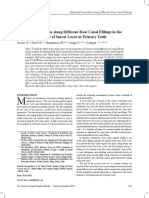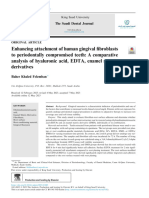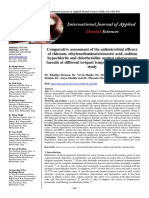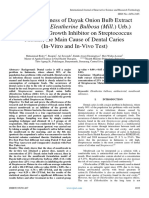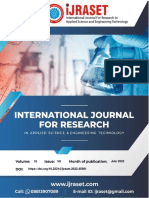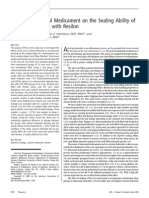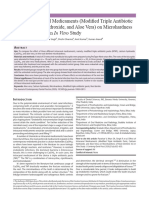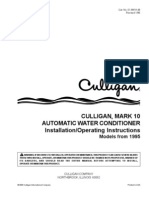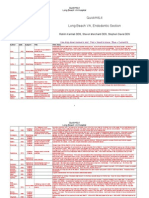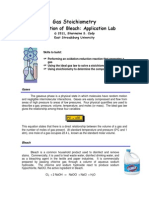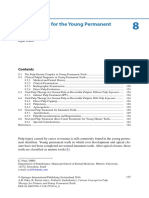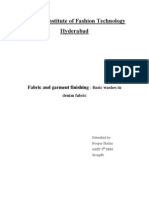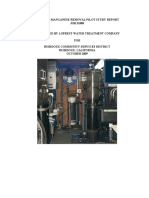Professional Documents
Culture Documents
In-Vitro Study of Lerak Fruit Ethanol Extract (SapindusRarak DC) On The Adhesion of Fusobacteriumnucleatum and Prevent Root Canal Wall Porosity PDF
Original Title
Copyright
Available Formats
Share this document
Did you find this document useful?
Is this content inappropriate?
Report this DocumentCopyright:
Available Formats
In-Vitro Study of Lerak Fruit Ethanol Extract (SapindusRarak DC) On The Adhesion of Fusobacteriumnucleatum and Prevent Root Canal Wall Porosity PDF
Copyright:
Available Formats
Volume 7, Issue 6, June – 2022 International Journal of Innovative Science and Research Technology
ISSN No:-2456-2165
In-Vitro Study of Lerak Fruit Ethanol
Extract (SapindusRarak DC) on the Adhesion of
Fusobacteriumnucleatum and Prevent
Root Canal Wall Porosity
Jihan Rahmadian Fitria
Conservative Dentistry Specialist program,
Department of Conservative Dentistry and Endodontics,
Dentistry Faculty, Universitas Sumatera Utara, Medan, Sumatera Utara, Indonesia
Nevi Yanti Basri A. Gani
Department of Conservative Dentistry and Endodontics, Department of Oral Biology,
Dentistry Faculty, Universitas Sumatera Utara, Medan, Dentistry Faculty, UniversitasSyiah Kuala,
Sumatera Utara, Indonesia Darussalam, Banda Aceh, Aceh, Indonesia.
Abstract:- Fusobacteriumnucleatum (F. nucleatum) has significant role in determining the invasion of the dentinal
been reported as a trigger for endodontic infections. This tubules (Bashir et al., 2015).
infection can be treated by cleaning and shaping
procedures using EDTA irrigation and NaOCl. Both of The microbiological point of view, endodontic
these materials have some drawbacks. Lerak fruit infections can be treated by chemical and mechanical
(Sapindusrarak DC) inhibited the growth of gram- procedures cleaning, and shaping. Mechanical debridement is
negative bacteria such as F. nucleatum. This study aimed an essential step for tissue removal and should always be
to evaluate the potential of Sapindusrarak DC in accompanied by irrigation to remove remnants of pulp tissue
inhibiting the development and formation of F. biomass and dentinal debris from the root canal system (Dennis et al.,
concerning the porosity of the root canal walls. This study 2021). Sodium hypochlorite ( NaOCl) 0.5%-5.25% is an
used F. nucleatum isolate ATCC 23726 and ethanol irrigating solution commonly used in endodontic treatment
extract of Lerak fruit. Using SEM, the assessment was because it has antimicrobial activity and can dissolve the
carried out by evaluating the biomass index, adhesion remaining pulp tissue. However, NaOCl can significantly
test, and root canal wall porosity. The results showed the reduce the Ca/P ratio of the root surface dentin and cause the
results showed Lerak fruit extract with concentrations dentin surface to be porous after being observed. Forty
(6.25%, 12.5%, 25%) had similarities with 2.5% NaOCl seconds resulted in a decrease in the mechanical properties of
solution + 17% EDTA (p>0.05) in preventing adhesion dentin by 75%9. NaOCl cannot be used as sole irrigation, and
and inhibiting the development of F. .nucleatum and it is often combined with a chelating agent such as
Lerak fruit extract 6.25%, 12.5%, 25% could prevent ethylenediamine tetra-acetic acid (EDTA) (Ok et al., 2015).
porosity better than 2.5% NaOCl irrigation solution + Irrigation with 17% EDTA for one minute followed by a
17% EDTA (p<0.05). The ethanolic extract of Lerak fruit final rinse with NaOCl is the most often recommended8.
can prevent adhesion, inhibit the growth of F.nucleatum However, the combination results in the opening of the
bacteria, and reduce excessive porosity in the tooth root dentinal tubules, destruction of intertubular dentin, reduction
canal wall. of dentin hardness, and substantial erosion of dentin (Afshan
et al., 2020).
Keywords:- Adhesion, Fusobacteriumnucleatum, Irigant
solution, Porosity, Sapindus Rarak DC. Due to the weakness of irrigation materials that are
often used, natural materials are used as an alternative to root
I. INTRODUCTION canal irrigation which can be expected to be better and more
biocompatible. One of the natural ingredients that can be
The ability of microorganisms to cause root canal developed for root canal irrigation is Lerak fruit
infection is influenced by virulence factors consisting of (Sapindusrarak DC)(Nevi Yanti and Prasetia, 2017). The
microbial products, the structure of cellular components, and pharmacological properties of Lerak fruit include antifungal,
strategies that contribute to pathogenicity. One of the bacteria bactericidal, and anti-inflammatory properties. The main
in the biofilm formed in endodontic infection is F. content of Lerak fruit is triterpenoidsaponins which are
nucleatum(Wong et al., 2021). It bacteria, including obligate surface-active compounds that act as surfactants (low surface
anaerobic gram-negative bacteria, and rods, is often found in tension) so that they can flow to areas that are not reached by
root canal infections with apical periodontitis, acute apical mechanical cleaning and act as detergents that can dissolve
abscess, post-endodontic infection, and pulp necrosis (Meng dirt, so it is related to the possible effect of Lerak fruit on the
et al., 2021). One of the virulence factors of F. nucleatum smear layer like organic and inorganic substances. An anti-
bacteria is adhesin which plays a role in cell attachment, adhesion test will be performed in this study to determine the
colonization, and coaggregation. Bacterial adhesion plays a potential of Lerak fruit extract in preventing bacterial
IJISRT22JUN1538 www.ijisrt.com 1751
Volume 7, Issue 6, June – 2022 International Journal of Innovative Science and Research Technology
ISSN No:-2456-2165
adhesion to the root canal to inhibit the growth of F. h, and 72 h, then weighed again.The scale value (g/mL)
nucleatum, as well as a biomass test to determine the became an indicator of biomass before and after interaction
interaction activity of F. nucleatum bacteria and an irrigation with F.nucleatum(Soraya and Alibasyah, 2021).
solution of Lerak fruit extract, as well as a porosity test. to
observe the clinical outcome on the root canal wall E. Scanning electron microscope of porosity
A total of 25 mandibular premolars were extracted
II. MATERIAL AND METHODS (sample criteria: the crown of the tooth was intact, the tooth
had one root and had one root canal, the tooth root was
A. Extraction of Lerak fruit relatively straight, there were no caries in the root canal,
The Lerak fruit was washed under running water, there was no crack, in essence, the tooth apex was utterly
weighed 940 grams, and the flesh was cut with a width of ± 3 closed, long teeth are selected between 15-18 mm). Then
mm, and dried in a drying cabinet at a temperature of ± 40˚C cleaned and put into a plastic container containing a saline
for one week.The dried fruit pieces were mashed, sifted, solution. The prepared teeth were sterilized in an autoclave
obtained powder, and then stored in a closed plastic for 18 hours at 37°C. Then the access cavity was prepared
container.Add 800 ml of 70% ethanol for maceration and using an endoaccess bur. 100 µL of BHI medium was added
then store in a closed container and allowed to stand for three to each group and incubated for 1.5 hours, then rinsed with
h.The mass is put into a percolator, pouredwith 200 mL of saline. Then, each group was injected with 25 µL of
70% ethanol, and filtered with a layer of filter paper.Leave F.nucleatum and incubated in an aerobic atmosphere for 6 h.
until the liquid drips, and the percolator is closed, left for 24
h,then evaporated with a vacuum rotary evaporator until a They determined working length with the help of a
thick extract is obtained with a honey-like caliper and root canal irrigation with K-file no. 10. Irrigation
consistency(Soraya et al., 2020). of the root canal using a 5 mL syringe with a two-side vented
needle type and size of 30 G, according to each treatment
B. Culture of Fusobacterium nucleatum group. Root canal preparation using Mtwo files from files
Fusobacteriumnucleatum culture was performed on #10.04 to #25.06 (VDW, Germany). After irrigation, then dry
Chromagar VRE media.The petri dish is divided into three with paper points. They were then incubated for 24 hours, 48
parts.Heat the oase needle and wait for it to cool, then take hours, and 72 h. The prepared teeth were stored in glycerol
onecolony of pure culture to be inoculated in area 1 with zig- solution, then rinsed with PBS solution for 10 seconds. The
zag strokes.Then reheat the oase needle and wait for it to tooth's root was cut vertically using the carborundum disc in
cool, followed by zig-zag strokes in area 2 perpendicular to a mesial-distal direction. The porosity examination with
the first stroke, then continued with zig-zag strokes in area 3. Scanning Electron Microscope (SEM) - JEOL JSM-6390A
The petri dish was tightly closed and incubated for 24 h at (1000x). It is to observe the porosity distribution in one-third
37°C in an anaerobic, then equalized with McFarland 0.5 or of the root canal. Furthermore, the porosity analysis using
equivalent to a concentration of 1.5x108 CFU/mL (Gani et Image-J software was carried out computerized to obtain the
al., 2015). results of the distribution of the total porosity
C. Adhesion Assay F. Statistical Analyses
Serial 96-well triple microplates were coated with 50 µL The anti-adhesion test was analyzed based on the group
Mueller-Hinton Broth (MHB) for 15 min and aspirated. Then of test materials with Kruskal Wallis and other statistics with
50 µL of F. nucleatum was added and incubated for 15 the Mann-Whitney test while based on incubation time with
minutes at room temperature, then 100 l of the test material one-way ANOVA and other statistics with LSD.The biomass
from each group was added and incubated for 24 h, 48 h, and test was analyzed based on the test material group with one-
72 h. Furthermore, all the test material in the microplate was way ANOVA and advanced statistics with LSD, incubation
aspirated, and each was given 50 l of 2% crystal violet for 5 time with Kruskal Wallis, and other statistics with the Mann-
min and washed with PBS (Phosphate Buffer Saline). Whitney test. The porosity value was analyzed based on the
Furthermore, Lugol's solution was given for 1 min and test material group and incubation time with a one-way
washed with PBS. The rest of the metabolism of cells that are ANOVA
not bacterial cells are dissolved in 96% alcohol for 20 sec.
Then, 50 µL of safranin solution was given for 2 minutes and III. RESULTS AND DISCUSSION
washed again with PBS. On a microplate basis, the anti-
adhesion activity of irrigating solution against F. nucleatum Figure 1 shows that the strongest anti-adhesion activity
cells was assessed by Spectrophotometry Elisa reader (Bio- occurred in the 25% Lerak fruit extract irrigation solution and
Rad Laboratories, Hercules, CA) at a wavelength of 620 nm 2.5% NaOCl irrigation solution at an incubation time of 72
(Mubarak et al., 2018). hours with an OD of 0.114 adhesins. Meanwhile, the lowest
anti-adhesion occurred in the 17% EDTA irrigation solution
D. Biomass Assay group at 48 hours of incubation, with an OD of 0.050
Bottles are weighed first with an analytical balance before adhesins. The incubation time of 72 hours was the strongest
being given an irrigation solution or bacteria.Then 3 ml was anti-adhesion property against F. nucleatum in all irrigation
taken in each group of irrigation solution and considered groups. Kruskal-Wallis statistical test yielded a p-value >
before incubation.This treatment was repeated in each 0.05, which indicated no significant difference between all
group's irrigation solution, interacting with 50 l of irrigation groups in preventing F. Nucleatum adhesion. In
F.nucleatum.Then it was incubated at 37°C for 24 hours, 48
IJISRT22JUN1538 www.ijisrt.com 1752
Volume 7, Issue 6, June – 2022 International Journal of Innovative Science and Research Technology
ISSN No:-2456-2165
contrast, there was a significant difference between In Figure 4, it is shown that the combination irrigation
incubation time and the one-way ANOVA test (p < 0.05). solution group of 2.5% NaOCl + 17% EDTA had the highest
porosity formation rate compared to the other test materials
The incubation time was analyzed using the LSD test. from all incubation times.They were followed by a 25%
The results showed that the incubation time of 24 hours Lerak fruit extract irrigation solution, while saline irrigation
significantly differed from those of 48 hours and 72 hours solution had the lowest porosity level.The one-way ANOVA
(p<0.05). The incubation time of 48 hours was also test resulted in a p-value <0.05, which indicated a significant
significantly different from the incubation time of 72 hours difference between all irrigation groups in forming the root
(p<0.05). canal walls' porosity. Between incubation times, there was no
significant difference (p>0.05). The incubation time was
analyzed using the LSD test. The results showed that the
incubation time of 24 hours was not significantly different
from the incubation time of 48 hours and 72 hours of
irrigation (p>0.05).The incubation time of 48 hours was also
not significantly different from the incubation time of 72
hours (p>0.05).
Fig. 1: Adhesion of Sapindusrarak DC to F. nuleatum
in root canals
In Figure 2, it is reported that the best irrigation solution
for inhibiting the development or activity of bacterial
fermentation, which is characterized by a low percentage of
biomass index, is the irrigation solution of 12.5% Lerak fruit Fig. 3: The scanning electron microscope of porosity profile
extract and 2.5% NaOCl with a total biomass of 16.1% at 24 on the tooth root canal wall.In the SEM images, each
incubation. O'clock. Meanwhile, the highest percentage of treatment with Lerak fruit extract 6.25% (A), Lerak 12.5%
biomass index indicating the weakest irrigation solution in (B), Lerak 25% (C), NaOCl 2.5% + EDTA 17% (D),
inhibiting the growth of F. nucleatum was EDTA, 17%, with Saline(E) with different incubation time variations after
a total biomass of 17.3% at 24 hours of incubation. interaction with F. nucleatum.
One-way ANOVA test yielded a p-value > 0.05, Bacterial adhesion is an important virulence factor in
indicating no significant difference between all irrigation pathogenesis and infection.The adhesion process is the initial
groups in preventing F. Nucleatum adhesion. While between stage of bacterial infection that plays a role in bacterial
incubation time and the Kruskal Wallis test, there was also no colonization on the surface of host cells1(Janoir,
significant difference (p>0.05). The incubation time was 2016).Adhesion of F. nucleatum to other bacteria and tooth
analyzed using the Mann-Whitney test. The results showed surfaces is caused by fimbrial and non-fimbrial
that the incubation time of 24 hours was not significantly adhesions.Five adhesins are involved in biofilm formation by
different from those of 48 hours and 72 hours (p>0.05). The F.nucleatum, such as FomA, 300-350 kDaGalactose-binding
incubation time of 48 hours was also not significantly adhesives, N-acetylneuraminic acid, and specific F.
different from the incubation time of 72 hours (p>0.05). nucleatumadhesins(Ding and Tan, 2016).
Fig. 2: Biomass index of Sapindusrarak DCirrigant solution
interacted with F. nucleatum in root canals Fig. 4:-The porosity of root canal walls after irrigation with
ethanolic extract of Sapindusrarak DCandF. nucleatum.
IJISRT22JUN1538 www.ijisrt.com 1753
Volume 7, Issue 6, June – 2022 International Journal of Innovative Science and Research Technology
ISSN No:-2456-2165
Based on the results of the Kruskal Wallis statistical Based on the results of the GCMS test on Lerak fruit
test, it was found that there was no significant difference in extract, there are several active components in Lerak fruit
the formation of anti-adhesion between the irrigation solution extract, such as 6-Octadecenoic acid (27.46%),
groups p>0.05 (0.904). The results of further statistical tests Dodecanamine N-Dimethyl (19.91%), and Hexadecanoic
using the Mann-Whitney test also showed no significant Acid (6.82%).These components play a role in inhibiting
difference (p<0.05) between one irrigation group and microbial growth by damaging the structure of cell walls and
another. So it can be assumed that Lerak fruit extracts of membranes.The active compounds in the Lerak fruit are 28%
various concentrations (6.25%, 12.5%, 25%) were as good as saponins, alkaloid compounds, polyphenols, antioxidant
2.5% NaOCl irrigation solution + 17% EDTA which became compounds and flavonoid groups, and tannins (Makarewicz
the gold standard in root canal irrigation in preventing et al., 2021).Polyphenols work as antibacterial by denaturing
adhesions. The presence of active components in the cell proteins and damaging plasma membranes.Alkaloids act
irrigating ingredients of the Lerak extract, such as flavonoids as antibacterials with the mechanism of interfering with the
and tannins, can also affect the adhesion of bacteria. arrangement of peptidoglycan in bacterial cells so that the
Flavonoids can deactivate adhesins from bacteria, thus formation of cell walls becomes imperfect, causing bacterial
affecting their adhesion ability. In addition, tannins can also cells to become efficiently lysed and ending in bacterial death
bind to the adhesin protein possessed by bacteria, thereby (Othman et al., 2019).
damaging the surface availability of bacterial cell receptors,
forming irreversible complex compounds with proline, The results of the third study based on the one-way
thereby inhibiting protein synthesis (Roy et al., 2018). The ANOVA statistical test showed a significant difference in the
results of this study are also in line with several previous porosity value of the type of irrigation solution test material p
studies, which showed that the antibacterial effect of the <0.05 (0.001). 2.5% NaOCl + 17% EDTA had the highest
ethanolic extract of Lerak fruit ranged from 0.01% to 25%. porosity at all incubation times, as seen on the Scanning
Electron Microscope (SEM). The results of further statistical
One way ANOVA statistical test based on incubation tests with LSD showed that the porosity level of 2.5% NaOCl
time showed a significant (p<0.05:0.001). The results of + 17% EDTA irrigation significantly differed from Lerak
further statistical tests with LSD also showed a significant extract of 6.25%, 12.5% , and 25%. So it can be assumed that
difference (p<0.05) between 24 hours, 48 hours, and 72 hours Lerak extract in various concentrations (6.25%, 12.5%, 25%)
incubation. The incubation time of 72 hours had the strongest did not cause excessive porosity compared to 2.5% NaOCl +
anti-adhesion activity and was significantly different from 24 17% EDTA, which became the gold standard for root canal
hours and 48 hours in all groups of irrigation solutions. It can irrigation. In addition, the porosity level based on incubation
be illustrated that time is related to activity between biofilm time showed no significant difference, p>0.05 (0.747) in both
formation as a cell adhesion pathway for F.nucleatum in host 24 hours, 48 hours, and 72 hours. It means that the type of
cells (Zhang et al., 2020). The 24- 48 hours are the highly test material in different groups determines the level of
proliferative phases of the development of F.nucleatum porosity, while the incubation time has no effect.
adhesion. It is related to the activity of F.nucleatum, which
can maintain itself stable during interaction with Demineralized dentin presents two types of porosity:
experimental materials(Proença et al., 2018). Bacteria have the first is tubular porosity, and the second is porosity due to
an extraordinary ability to defend themselves from stress the collagen meshwork.Porosities due to these tubules have
responses to the environment. When there is a lack of been reported to be 12–32% and 21%, with a mean tubular
nutrients, they enter the stationary phase (resting phase)by diameter of 3–3.5 mm for demineralized dentin (Shen et al.,
developing resistance cells (Bertrand, 2019). 2018).This study showed the formation of more porosity in
the 2.5% NaOCl + 17% EDTA group in the form of a larger
The results of the second study were regarding dentinal tubule size. There were several secondary tubules
assessing the activity of the irrigation solution against observed in the intertubular dentin.It is in line with research
F.nucleatum bacteria considered from the biomass index. by Gorduysus et al. (2015), where erosion occurred around
This principle measures the potential of an irrigating solution the dentinal tubules in the 17% EDTA and 2.5% NaOCl
in inhibiting the development or activity of F.nucleatum combination group.SEM images show excessive dentin
fermentation. The smaller the percentage of the biomass degradation causing the intertubular dentin to disintegrate
index, the stronger the role of the irrigation solution in and the conjugation of two or more dentinal tubules, resulting
preventing bacterial activity from synthesizing the active in enlarged dentinal tubules with an irregular shape.
compounds contained in the test material. The one-way
ANOVA statistical test showed an insignificant difference Hypochlorous acid contained in NaOCl, when in
between the biomass index and the irrigation solution groups, contact with organic tissue, will release chlorine combined
p> 0.05 (0.051). Further statistical tests with LSD showed no with amino acid groups to produce chloramines in the
significant difference between 6.25%, 12.5% , and 25% chloramination reaction10.Sodium hypochlorite breaks down
Lerak fruit extract irrigation solution and 2.5% NaOCl + 17% the peptide chain, and the protein chlorinate group results in
EDTA irrigation solution. So it can be assumed that Lerak N-chloramine being broken down into other parts, causing
extract in various concentrations (6.25%, 12.5%, 25%) is as collagen and proteoglycan breakdown (da Cruz Nizer et al.,
good as 2.5% NaOCl + 17% EDTA, which is the gold 2020).EDTA can dissolve inorganic tissues by removing
standard for root canal irrigation in inhibiting fermentation metal ions such as calcium and chemically binding them
activity and development of F. nucleatum. through two nitrogen atoms in the amino group and four
oxygen atoms in the carbonic group, causing decalcification
IJISRT22JUN1538 www.ijisrt.com 1754
Volume 7, Issue 6, June – 2022 International Journal of Innovative Science and Research Technology
ISSN No:-2456-2165
of dentin(Guo et al., 2019).The greater the volume negative bacteria to hypochlorous acid.
concentration of protein, the significantly reduced impact of Microorganisms 2020;8:1220.
damage to the protein-mineral surface on dentin.Dentin [6]. Dennis D, Farahanny W, Prasetia W et al. Biological
becomes porous due to the loss of dentin minerals and and mechanical principles of chemomechanical
denaturation of the collagen matrix (Abdallah et al., 2018). preparation in root canal therapy: a review.
International Journal of Clinical Dentistry
The ability of the Lerak fruit extract to remove the 2021;14:187-198.
smear layer is due to the presence of saponins which are the [7]. Ding Q, Tan KS. The danger signal extracellular ATP
active components of the Lerak fruit extract which act as is an inducer of Fusobacterium nucleatum biofilm
surfactants that can flow into inaccessible areas by dispersal. Front Cell Infect Microbiol 2016;6:155.
mechanical cleaning and act as detergents that can dissolve [8]. Gani BA, Nasution AI, Nazaruddin N et al. Potential
dirt, so it is associated with the possible effect of Lerak fruit of Jatropha multifida sap against traumatic ulcer.
against organic and inorganic smear layers(Nevi Yanti and Dental Journal (Majalah Kedokteran Gigi)
Prasetia, 2017). Hydrophilic (polar compounds) and 2015;48:119-125.
hydrophobic (non-polar compounds) groups in Lerak fruit [9]. Guo J-m, Makvandi P, Wei C-c, Chen J-h, Xu H-k,
allow saponins to dissolve organic and inorganic components Breschi L, Pashley DH, Huang C et al. Polymer
in tooth root canals. The smear layer, an inorganic layer of conjugation optimizes EDTA as a calcium-chelating
dentin that mostly contains calcium hydroxyapatite and agent that exclusively removes extrafibrillar minerals
tricalcium phosphate, a non-polar compound, will dissolve in from mineralized collagen. Acta Biomater 2019;
the hydrophobic group (non-polar compound) of the saponins 90:424-440.
in the Lerak fruit (Pribadi et al., 2019). So from the SEM [10]. Janoir C. Virulence factors of Clostridium difficile and
image, it can be seen that irrigation solutions derived from their role during infection. Anaerobe 2016;37:13-24.
nature, such as Lerak fruit extract, can clean the smear layer [11]. Makarewicz M, Drożdż I, Tarko T et al. The
without causing excessive erosion of the root canal walls. Interactions between Polyphenols and
Microorganisms, Especially Gut Microbiota.
IV. CONCLUSION Antioxidants (Basel) 2021;10:188.
Lerak fruit extract in various concentrations (6.25%, [12]. Meng Q, Gao Q, Mehrazarin S et al. Fusobacterium
12.5%, 25%) was not significantly different from the 2.5% nucleatum secretes amyloid‐like FadA to enhance
NaOCl + 17% EDTA solution, which became the gold pathogenicity. EMBO reports 2021;22:e52891.
standard in root canal irrigation of teeth in preventing [13]. Mubarak Z, Humaira A, Gani BA et al. Preliminary
bacterial adhesion and inhibiting growthF.nucleatum.While study on the inhibitory effect of seaweed Gracilaria
clinically Lerak extract in various concentrations (6.25%, verrucosa extract on biofilm formation of Candida
12.5%, 25%) was better because it did not cause excessive albicans cultured from the saliva of a smoker.
porosity at all incubation times compared to 2.5% NaOCl + 2018;F1000Research 7.
17% EDTA, which became the gold standard for [14]. Nevi Yanti D, Prasetia W. The Ability of Root Canal
irrigationroot canal Irrigant With Ethanol Extract of Lerak Fruit (Sapindus
Rarak Dc) in Removing Root Canal Smear Layer (A
ACKNOWLEDGMENT Sem Study). IOSR Journal of Dental and Medical
Sciences 2017;16:24-30.
Thank you to the Dental Research Laboratory, Faculty [15]. Ok E, Adanir N, Hakki S. Comparison of cytotoxicity
of Dentistry, UniversitasSyiah Kuala, Darussalam, Banda of various concentrations origanum extract solution
Aceh, Indonesia, for facilitating the examination of the with 2% chlorhexidine gluconate and 5.25% sodium
biomass and adhesion assays of Fusobacteriumnuleatum hypochlorite. European journal of dentistry 2015;
9:006-010.
REFERENCES [16]. Othman L, Sleiman A, Abdel-Massih RM.
Antimicrobial Activity of Polyphenols and Alkaloids
[1]. Abdallah M-N, Abughanam G, Tran SD et al. in Middle Eastern Plants. Frontiers in microbiology
Comparative adsorption profiles of basal lamina 2019;10:911-911.
proteome and gingival cells onto dental and titanium [17]. Pribadi N, Samadi K, Astuti MN et al. The differences
surfaces. Acta Biomater 2018;73:547-558. in root canal smear layer removal between 6, 25%
[2]. Afshan Z, Jat SA, Khan JA et al. Erosive potential of pineapple (Ananas comocus L. Merr.) peel extract and
1% phytic acid on radicular dentine at different time 17% Ethylene diamine tetra-acetic acid. Dental Journal
intervals. European endodontic journal 2020;5:28. (Majalah Kedokteran Gigi) 2019; 52:122-125.
[3]. Bashir A, Miskeen AY, Bhat A et al. Fusobacterium [18]. Proença MA, Biselli JM, Succi M, at al.. Relationship
nucleatum. European Journal of Cancer Prevention between Fusobacterium nucleatum, inflammatory
2015;24:373-385. mediators and microRNAs in colorectal
[4]. Bertrand RL. Lag phase is a dynamic, organized, carcinogenesis. World Journal Gastroenterol
adaptive, and evolvable period that prepares bacteria 2018;24:5351.
for cell division. J Bacteriol 2019;201:e00697-00618. [19]. Roy R, Tiwari M, Donelli. Strategies for combating
[5]. da Cruz Nizer WS, Inkovskiy V, Overhage J. bacterial biofilms: A focus on anti-biofilm agents and
Surviving reactive chlorine stress: Responses of gram- their mechanisms of action. Virulence 2018;9:522-554.
IJISRT22JUN1538 www.ijisrt.com 1755
Volume 7, Issue 6, June – 2022 International Journal of Innovative Science and Research Technology
ISSN No:-2456-2165
[20]. Shen X, Li L, Cui W, Feng Y. Improvement of fractal
model for porosity and permeability in porous
materials. International Journal of Heat and Mass
Transfer 2018;121:1307-1315.
[21]. Soraya C, Alibasyah ZM, Gani, BA. Biomass index
and viscosity values of Moringa oleifera that
influenced by Enterococcus faecalis. Journal of Syiah
Kuala Dentistry Society 2021;6:1-5.
[22]. Soraya C, Mubarak Z and Gani BA. The growth and
biofilm formation of Enterococcus faecalis in ethanol
extract of Citrus aurantiifolia Indonesian species.
Journal of Pharmacy & Pharmacognosy Research
2020;8:558-568.
[23]. Wong J, Manoil D, Näsman P et al Microbiological
aspects of root canal infections and disinfection
strategies: an update review on the current knowledge
and challenges. Frontiers in Oral Health 2021;
2:672887.
[24]. Zhang S, Li C, Liu J et al. Fusobacterium nucleatum
promotes epithelial‐mesenchymal transiton through
regulation of the lncRNA
MIR4435‐2HG/miR‐296‐5p/Akt2/SNAI1 signaling
pathway. The FEBS journal 2020;287:4032-4047.
IJISRT22JUN1538 www.ijisrt.com 1756
You might also like
- WCMBR-20(U) Marine Membrane Sewage Treatment Plant InstructionsDocument19 pagesWCMBR-20(U) Marine Membrane Sewage Treatment Plant InstructionsAshitoshNo ratings yet
- Chemical Resistance Table Provides InsightsDocument5 pagesChemical Resistance Table Provides Insightsnoto.sugiartoNo ratings yet
- Active Ingredient(s) of Cleaning ProductsDocument25 pagesActive Ingredient(s) of Cleaning ProductsZairra Dela Cruz100% (2)
- Adam1992 Hypochlorous Acid Decomposition in The PH 5-8 RegionDocument8 pagesAdam1992 Hypochlorous Acid Decomposition in The PH 5-8 RegionGregorio ValeroNo ratings yet
- Bioactivity of Lerak Fruit Extract (Sapindusrarak DC) As An Endodontic Irrigants To Inhibition The Fusobacteriumnucleatum Virulence and Relate To The Fracture Resistance of Root Canal PDFDocument5 pagesBioactivity of Lerak Fruit Extract (Sapindusrarak DC) As An Endodontic Irrigants To Inhibition The Fusobacteriumnucleatum Virulence and Relate To The Fracture Resistance of Root Canal PDFInternational Journal of Innovative Science and Research TechnologyNo ratings yet
- Bacterial Penetration Along Different Root Canal Fillings in The Presence or Absence of Smear Layer in Primary TeethDocument6 pagesBacterial Penetration Along Different Root Canal Fillings in The Presence or Absence of Smear Layer in Primary TeethRoyal LibraryNo ratings yet
- Comparative Evaluation of Antibacterial Efficacy of Newer Intracanal Medicament Nitrofurantoin and Ozonated Oil Plus Calcium Hydroxide On E.faecalis - An in Vitro StudyDocument5 pagesComparative Evaluation of Antibacterial Efficacy of Newer Intracanal Medicament Nitrofurantoin and Ozonated Oil Plus Calcium Hydroxide On E.faecalis - An in Vitro StudyInternational Journal of Innovative Science and Research TechnologyNo ratings yet
- Aquatine Endodontic Cleanser Effectiveness Against Smear LayerDocument6 pagesAquatine Endodontic Cleanser Effectiveness Against Smear Layeraulia lubisNo ratings yet
- Garcia 2010Document6 pagesGarcia 2010VivianColoradoGomezNo ratings yet
- Antibacterial Activity of Water Hyacinth (Eichhornia Crassipes) Leaf Extract Against Bacterial Plaque From Gingivitis PatientsDocument6 pagesAntibacterial Activity of Water Hyacinth (Eichhornia Crassipes) Leaf Extract Against Bacterial Plaque From Gingivitis PatientsRAKERNAS PDGI XINo ratings yet
- The Spray Effect of Peronema Canescens Jack As A Disinfectant Against The Growth of Staphylococcus Aureus On The Surface of Alginate MoldsDocument4 pagesThe Spray Effect of Peronema Canescens Jack As A Disinfectant Against The Growth of Staphylococcus Aureus On The Surface of Alginate MoldsInternational Journal of Innovative Science and Research TechnologyNo ratings yet
- بحث التخرج سجى فتاحDocument50 pagesبحث التخرج سجى فتاحFlorida ManNo ratings yet
- EDTA 1 - (16 Lembar)Document6 pagesEDTA 1 - (16 Lembar)Ines VionaNo ratings yet
- 13 RoleofsealersonE FaecalisDocument4 pages13 RoleofsealersonE FaecalisMihaela TuculinaNo ratings yet
- In-Vitro Antimicrobial Activity of Nano-Chitosan Hydroxyapatite Against Streptococcus Mutans On Biofilm FormationDocument8 pagesIn-Vitro Antimicrobial Activity of Nano-Chitosan Hydroxyapatite Against Streptococcus Mutans On Biofilm FormationInternational Journal of Innovative Science and Research TechnologyNo ratings yet
- In Vitro StudyDocument6 pagesIn Vitro StudyMind Mapping Dept of Cons & EndoNo ratings yet
- Intracanal Heating of IrrigantsDocument6 pagesIntracanal Heating of IrrigantsKhatija MemonNo ratings yet
- Keywords:-Zot, Zop and ZoeDocument6 pagesKeywords:-Zot, Zop and ZoeInternational Journal of Innovative Science and Research TechnologyNo ratings yet
- GenDent JF20 GambinDocument4 pagesGenDent JF20 GambinDiego GambinNo ratings yet
- 8IJAERS 01202115 AnalysisDocument5 pages8IJAERS 01202115 AnalysisIJAERS JOURNALNo ratings yet
- JConservDent25120-1297819 033618Document6 pagesJConservDent25120-1297819 033618boopathiraja.chinnasamyNo ratings yet
- Dentistry Journal: Impact of Di Bacterial Elimination From Infected Root CanalsDocument9 pagesDentistry Journal: Impact of Di Bacterial Elimination From Infected Root Canalspatel keralNo ratings yet
- Root Canal Irrigants in Primary TeethDocument6 pagesRoot Canal Irrigants in Primary TeethsyedNo ratings yet
- Novel Rootcanal IrrigantsDocument14 pagesNovel Rootcanal IrrigantsiddrxNo ratings yet
- Removal Efficacy of Propoliscalcium Hydroxide MediDocument6 pagesRemoval Efficacy of Propoliscalcium Hydroxide Medifelipe martinezNo ratings yet
- Retreatment Efficacy of Endodontic Bioceramic Sealers: A Review of The LiteratureDocument12 pagesRetreatment Efficacy of Endodontic Bioceramic Sealers: A Review of The LiteratureEndriyana NovitasariNo ratings yet
- Keywords: Eleutherine Bulbosa, Antibacterial, Mouthwash: SubstanceDocument4 pagesKeywords: Eleutherine Bulbosa, Antibacterial, Mouthwash: SubstanceInternational Journal of Innovative Science and Research TechnologyNo ratings yet
- Comparison Among Four Commonly Used Demineralizing Agents For Root Conditioning. A Scanning Electron MicrosDocument7 pagesComparison Among Four Commonly Used Demineralizing Agents For Root Conditioning. A Scanning Electron MicrosAbdul Aziz Abdul GaniNo ratings yet
- JIndianSocPeriodontol18132-3982937 110349Document6 pagesJIndianSocPeriodontol18132-3982937 110349arpita7dr9693No ratings yet
- MainDocument5 pagesMainRaji MurthyNo ratings yet
- MainDocument5 pagesMainRaji MurthyNo ratings yet
- Endodontic Management of Open Apex Using Biodentine As A Novel Apical MatrixDocument4 pagesEndodontic Management of Open Apex Using Biodentine As A Novel Apical MatrixRuchi ShahNo ratings yet
- Etidronate irrigation effects on root dentin roughnessDocument7 pagesEtidronate irrigation effects on root dentin roughnessAlina AlexandraNo ratings yet
- 10 VII July 2022Document9 pages10 VII July 2022IJRASETPublicationsNo ratings yet
- A Comparison of The Efficacy of Various Disinfection Protocols in Endodontic Treatment: An in Vitro StudyDocument6 pagesA Comparison of The Efficacy of Various Disinfection Protocols in Endodontic Treatment: An in Vitro StudyTaufiq AlghofiqiNo ratings yet
- IJCPD-15-S12Document6 pagesIJCPD-15-S12Shameena KnNo ratings yet
- Endodontic Surgery in A Lower Molar Affected by Root Resorption and Fractured InstrumentDocument5 pagesEndodontic Surgery in A Lower Molar Affected by Root Resorption and Fractured InstrumentIJAERS JOURNALNo ratings yet
- An Investigation On The Antibacterial and Antibiofilm Efficacy of Cationic Nanoparticulates For Root Canal DisinfectionDocument6 pagesAn Investigation On The Antibacterial and Antibiofilm Efficacy of Cationic Nanoparticulates For Root Canal DisinfectionLore Saldivar OrihuelaNo ratings yet
- Influence of Temperature On The Antibacterial Activity of Sodium HypochloriteDocument5 pagesInfluence of Temperature On The Antibacterial Activity of Sodium HypochloriteMARIA NAENo ratings yet
- Wahyuningtyas 2008Document4 pagesWahyuningtyas 2008Shankar arumugamNo ratings yet
- The Effect of 17% Ethylenediaminetetra-Acetic Acid As A Main Irrigation On Apical Root Canal Cleanliness (Ex Vivo)Document8 pagesThe Effect of 17% Ethylenediaminetetra-Acetic Acid As A Main Irrigation On Apical Root Canal Cleanliness (Ex Vivo)utama 3002No ratings yet
- Self-Etching Adhesives Increase Collagenolytic Activity in Radicular DentinDocument7 pagesSelf-Etching Adhesives Increase Collagenolytic Activity in Radicular DentinPablo BenitezNo ratings yet
- Apical Closure in ApexificationA ReviewDocument5 pagesApical Closure in ApexificationA ReviewLaura RuZeNo ratings yet
- Sapindus and Lemon JCDDocument6 pagesSapindus and Lemon JCDnaveenNo ratings yet
- In Vitro Effect of Cavity Disinfectants On The Bond Strength ofDocument6 pagesIn Vitro Effect of Cavity Disinfectants On The Bond Strength ofJorge Alberto Hernández MenjívarNo ratings yet
- ADJALEXU - Volume 43 - Issue 2 - Pages 7-12Document6 pagesADJALEXU - Volume 43 - Issue 2 - Pages 7-12Belinda SalmaNo ratings yet
- Removal Techniques For Intracanal Medicament-A ReviewDocument5 pagesRemoval Techniques For Intracanal Medicament-A ReviewMohammad YousifNo ratings yet
- BPJ - Vol - 12 - No - 2 - P - 965-974Document10 pagesBPJ - Vol - 12 - No - 2 - P - 965-974bilisankarNo ratings yet
- GARLIC - Evaluation of Nanomagnesium Oxide in Combination With Garlic Extract as an Endodontic Irrigant an in Vitro StuDocument8 pagesGARLIC - Evaluation of Nanomagnesium Oxide in Combination With Garlic Extract as an Endodontic Irrigant an in Vitro StuLaraduta AgustiniNo ratings yet
- 1 PBDocument10 pages1 PBRieza Zulfahmi TaftazaniNo ratings yet
- Coffee Skin Boosts Tooth Extraction HealingDocument7 pagesCoffee Skin Boosts Tooth Extraction HealingDavid VanNo ratings yet
- Intracanal Medicament and ResilonDocument5 pagesIntracanal Medicament and ResilonLuLu NikhlaturNo ratings yet
- MTA-NO mixture antimicrobial activity biocompatibilityDocument8 pagesMTA-NO mixture antimicrobial activity biocompatibilityDaniel S. ContrerasNo ratings yet
- Parashar, V., Et Al (2020)Document4 pagesParashar, V., Et Al (2020)Robas BasathaNo ratings yet
- Endodontic Irrigants A ReviewDocument8 pagesEndodontic Irrigants A ReviewAthenaeum Scientific PublishersNo ratings yet
- Zeolite-Embedded Silver Extends Antimicrobial Activity of Dental AcrylicsDocument6 pagesZeolite-Embedded Silver Extends Antimicrobial Activity of Dental AcrylicsMario Rivera CortesNo ratings yet
- TaftiDocument5 pagesTaftiAhmad BukhariNo ratings yet
- John PaulDocument12 pagesJohn PaulFajar Dwi YudantoNo ratings yet
- Effervesecent Denturecleaning Granulesusing CloveoilDocument6 pagesEffervesecent Denturecleaning Granulesusing CloveoilShankar arumugamNo ratings yet
- Comparing the Antimicrobial Efficacy of Biopure MTAD and Sodium HypochloriteDocument7 pagesComparing the Antimicrobial Efficacy of Biopure MTAD and Sodium HypochloriteShanty AnitaNo ratings yet
- Endo VacDocument5 pagesEndo Vacisha MehtaNo ratings yet
- Antifungal Efficacy of Green Tea Extract Against Candida Albicans Biofilm On Tooth SubstrateDocument7 pagesAntifungal Efficacy of Green Tea Extract Against Candida Albicans Biofilm On Tooth SubstrateDennaya Listya DiasNo ratings yet
- Paper Pedo TrsnalteDocument15 pagesPaper Pedo TrsnaltecahayaNo ratings yet
- Parastomal Hernia: A Case Report, Repaired by Modified Laparascopic Sugarbaker TechniqueDocument2 pagesParastomal Hernia: A Case Report, Repaired by Modified Laparascopic Sugarbaker TechniqueInternational Journal of Innovative Science and Research TechnologyNo ratings yet
- Smart Health Care SystemDocument8 pagesSmart Health Care SystemInternational Journal of Innovative Science and Research TechnologyNo ratings yet
- Visual Water: An Integration of App and Web to Understand Chemical ElementsDocument5 pagesVisual Water: An Integration of App and Web to Understand Chemical ElementsInternational Journal of Innovative Science and Research TechnologyNo ratings yet
- Air Quality Index Prediction using Bi-LSTMDocument8 pagesAir Quality Index Prediction using Bi-LSTMInternational Journal of Innovative Science and Research TechnologyNo ratings yet
- Smart Cities: Boosting Economic Growth through Innovation and EfficiencyDocument19 pagesSmart Cities: Boosting Economic Growth through Innovation and EfficiencyInternational Journal of Innovative Science and Research TechnologyNo ratings yet
- Parkinson’s Detection Using Voice Features and Spiral DrawingsDocument5 pagesParkinson’s Detection Using Voice Features and Spiral DrawingsInternational Journal of Innovative Science and Research TechnologyNo ratings yet
- Predict the Heart Attack Possibilities Using Machine LearningDocument2 pagesPredict the Heart Attack Possibilities Using Machine LearningInternational Journal of Innovative Science and Research TechnologyNo ratings yet
- Impact of Silver Nanoparticles Infused in Blood in a Stenosed Artery under the Effect of Magnetic Field Imp. of Silver Nano. Inf. in Blood in a Sten. Art. Under the Eff. of Mag. FieldDocument6 pagesImpact of Silver Nanoparticles Infused in Blood in a Stenosed Artery under the Effect of Magnetic Field Imp. of Silver Nano. Inf. in Blood in a Sten. Art. Under the Eff. of Mag. FieldInternational Journal of Innovative Science and Research TechnologyNo ratings yet
- An Analysis on Mental Health Issues among IndividualsDocument6 pagesAn Analysis on Mental Health Issues among IndividualsInternational Journal of Innovative Science and Research TechnologyNo ratings yet
- Compact and Wearable Ventilator System for Enhanced Patient CareDocument4 pagesCompact and Wearable Ventilator System for Enhanced Patient CareInternational Journal of Innovative Science and Research TechnologyNo ratings yet
- Implications of Adnexal Invasions in Primary Extramammary Paget’s Disease: A Systematic ReviewDocument6 pagesImplications of Adnexal Invasions in Primary Extramammary Paget’s Disease: A Systematic ReviewInternational Journal of Innovative Science and Research TechnologyNo ratings yet
- Terracing as an Old-Style Scheme of Soil Water Preservation in Djingliya-Mandara Mountains- CameroonDocument14 pagesTerracing as an Old-Style Scheme of Soil Water Preservation in Djingliya-Mandara Mountains- CameroonInternational Journal of Innovative Science and Research TechnologyNo ratings yet
- Exploring the Molecular Docking Interactions between the Polyherbal Formulation Ibadhychooranam and Human Aldose Reductase Enzyme as a Novel Approach for Investigating its Potential Efficacy in Management of CataractDocument7 pagesExploring the Molecular Docking Interactions between the Polyherbal Formulation Ibadhychooranam and Human Aldose Reductase Enzyme as a Novel Approach for Investigating its Potential Efficacy in Management of CataractInternational Journal of Innovative Science and Research TechnologyNo ratings yet
- Insights into Nipah Virus: A Review of Epidemiology, Pathogenesis, and Therapeutic AdvancesDocument8 pagesInsights into Nipah Virus: A Review of Epidemiology, Pathogenesis, and Therapeutic AdvancesInternational Journal of Innovative Science and Research TechnologyNo ratings yet
- Harnessing Open Innovation for Translating Global Languages into Indian LanuagesDocument7 pagesHarnessing Open Innovation for Translating Global Languages into Indian LanuagesInternational Journal of Innovative Science and Research TechnologyNo ratings yet
- The Relationship between Teacher Reflective Practice and Students Engagement in the Public Elementary SchoolDocument31 pagesThe Relationship between Teacher Reflective Practice and Students Engagement in the Public Elementary SchoolInternational Journal of Innovative Science and Research TechnologyNo ratings yet
- Investigating Factors Influencing Employee Absenteeism: A Case Study of Secondary Schools in MuscatDocument16 pagesInvestigating Factors Influencing Employee Absenteeism: A Case Study of Secondary Schools in MuscatInternational Journal of Innovative Science and Research TechnologyNo ratings yet
- Dense Wavelength Division Multiplexing (DWDM) in IT Networks: A Leap Beyond Synchronous Digital Hierarchy (SDH)Document2 pagesDense Wavelength Division Multiplexing (DWDM) in IT Networks: A Leap Beyond Synchronous Digital Hierarchy (SDH)International Journal of Innovative Science and Research TechnologyNo ratings yet
- Diabetic Retinopathy Stage Detection Using CNN and Inception V3Document9 pagesDiabetic Retinopathy Stage Detection Using CNN and Inception V3International Journal of Innovative Science and Research TechnologyNo ratings yet
- Advancing Healthcare Predictions: Harnessing Machine Learning for Accurate Health Index PrognosisDocument8 pagesAdvancing Healthcare Predictions: Harnessing Machine Learning for Accurate Health Index PrognosisInternational Journal of Innovative Science and Research TechnologyNo ratings yet
- Auto Encoder Driven Hybrid Pipelines for Image Deblurring using NAFNETDocument6 pagesAuto Encoder Driven Hybrid Pipelines for Image Deblurring using NAFNETInternational Journal of Innovative Science and Research TechnologyNo ratings yet
- Formulation and Evaluation of Poly Herbal Body ScrubDocument6 pagesFormulation and Evaluation of Poly Herbal Body ScrubInternational Journal of Innovative Science and Research TechnologyNo ratings yet
- The Utilization of Date Palm (Phoenix dactylifera) Leaf Fiber as a Main Component in Making an Improvised Water FilterDocument11 pagesThe Utilization of Date Palm (Phoenix dactylifera) Leaf Fiber as a Main Component in Making an Improvised Water FilterInternational Journal of Innovative Science and Research TechnologyNo ratings yet
- The Making of Object Recognition Eyeglasses for the Visually Impaired using Image AIDocument6 pagesThe Making of Object Recognition Eyeglasses for the Visually Impaired using Image AIInternational Journal of Innovative Science and Research TechnologyNo ratings yet
- The Impact of Digital Marketing Dimensions on Customer SatisfactionDocument6 pagesThe Impact of Digital Marketing Dimensions on Customer SatisfactionInternational Journal of Innovative Science and Research TechnologyNo ratings yet
- Electro-Optics Properties of Intact Cocoa Beans based on Near Infrared TechnologyDocument7 pagesElectro-Optics Properties of Intact Cocoa Beans based on Near Infrared TechnologyInternational Journal of Innovative Science and Research TechnologyNo ratings yet
- A Survey of the Plastic Waste used in Paving BlocksDocument4 pagesA Survey of the Plastic Waste used in Paving BlocksInternational Journal of Innovative Science and Research TechnologyNo ratings yet
- Cyberbullying: Legal and Ethical Implications, Challenges and Opportunities for Policy DevelopmentDocument7 pagesCyberbullying: Legal and Ethical Implications, Challenges and Opportunities for Policy DevelopmentInternational Journal of Innovative Science and Research TechnologyNo ratings yet
- Comparatively Design and Analyze Elevated Rectangular Water Reservoir with and without Bracing for Different Stagging HeightDocument4 pagesComparatively Design and Analyze Elevated Rectangular Water Reservoir with and without Bracing for Different Stagging HeightInternational Journal of Innovative Science and Research TechnologyNo ratings yet
- Design, Development and Evaluation of Methi-Shikakai Herbal ShampooDocument8 pagesDesign, Development and Evaluation of Methi-Shikakai Herbal ShampooInternational Journal of Innovative Science and Research Technology100% (3)
- Lesson 1 - Clinical Laboratory Laws RA 4688 & I'ts Implementing Guideliines (AO 2007 - 0027)Document8 pagesLesson 1 - Clinical Laboratory Laws RA 4688 & I'ts Implementing Guideliines (AO 2007 - 0027)Marjan CalzadoNo ratings yet
- 4010 4011 5016 650 Series - UMF Medical - Owners ManualDocument18 pages4010 4011 5016 650 Series - UMF Medical - Owners ManualHobi's WaifuNo ratings yet
- How To Grow Chillies 2013 V4 OCTDocument4 pagesHow To Grow Chillies 2013 V4 OCTstormbrushNo ratings yet
- Aldehydes and KetonesDocument5 pagesAldehydes and KetonesFlorence Lynn BaisacNo ratings yet
- All in One - 10th Class em - Fa-2Document35 pagesAll in One - 10th Class em - Fa-2sai ramxeroxNo ratings yet
- ZenTreat D 100 (TDS)Document1 pageZenTreat D 100 (TDS)Abhay BhoirNo ratings yet
- Disinfection Methods and Chlorination ProcessDocument20 pagesDisinfection Methods and Chlorination ProcessMuhammad Husnain IjazNo ratings yet
- DisinfectionDocument30 pagesDisinfectionBabita PatnaikNo ratings yet
- Culligan Water Conditioner 1994-1998Document17 pagesCulligan Water Conditioner 1994-1998Jay SommersNo ratings yet
- Sustainability in DenimDocument29 pagesSustainability in DenimPrerna KhatriNo ratings yet
- Durco BTV-2000 Valve: Lined Chemical Service ValvesDocument12 pagesDurco BTV-2000 Valve: Lined Chemical Service Valveskagasaw023No ratings yet
- Baño María PolyscienceDocument19 pagesBaño María PolyscienceSebastian Martinez CuautencoNo ratings yet
- QuickhitliteratureguideDocument69 pagesQuickhitliteratureguideralsulaimani100% (1)
- Gas Stoichiometry: Composition of Bleach: Application LabDocument6 pagesGas Stoichiometry: Composition of Bleach: Application LabTaofik NurdiansahNo ratings yet
- HKDSE Chemistry: (Paper 2) Mock Examination 4Document6 pagesHKDSE Chemistry: (Paper 2) Mock Examination 4Vinaigrette HeNo ratings yet
- Dioxid de Clor DWT Technical DiscussionDocument16 pagesDioxid de Clor DWT Technical DiscussionAdrian BorsosNo ratings yet
- Environmental Pollution: ReviewDocument15 pagesEnvironmental Pollution: ReviewTiago TorresNo ratings yet
- 3 Extracted Pages From Anna B. Fuks, Benjamin Peretz Eds. Pediatric Endodontics Current Concepts in Pulp Therapy For Primary and Young Permanent TeethDocument32 pages3 Extracted Pages From Anna B. Fuks, Benjamin Peretz Eds. Pediatric Endodontics Current Concepts in Pulp Therapy For Primary and Young Permanent TeethMona CameliaNo ratings yet
- Visionaire 2 3 Service Manual English PDFDocument47 pagesVisionaire 2 3 Service Manual English PDFQuarmina HesseNo ratings yet
- CHM2 Kinetics and Equilibria Q2Document29 pagesCHM2 Kinetics and Equilibria Q2Hakim Abbas100% (1)
- Is.2720.37.1976 Sand Equivalent ValueDocument21 pagesIs.2720.37.1976 Sand Equivalent Valuerajeshji_000No ratings yet
- National Institute of Fashion Technology Hyderabad Fabric and garment finishing : Basic washes in denim fabricDocument13 pagesNational Institute of Fashion Technology Hyderabad Fabric and garment finishing : Basic washes in denim fabricSundaramoorthy ManickamNo ratings yet
- Synthesis of Camphor PDFDocument4 pagesSynthesis of Camphor PDFJijia BaiNo ratings yet
- Stainless Steel Corrosion by Chloride IonsDocument32 pagesStainless Steel Corrosion by Chloride Ionssureshjeeva0% (1)
- Typical PDFDocument24 pagesTypical PDFKari ConwayNo ratings yet
- Plasite 4500 S: Selection & Specification DataDocument5 pagesPlasite 4500 S: Selection & Specification DataY. Ashok KumarNo ratings yet





